The upma made with sooji/rava or cream of wheat (semolina) is a very common breakfast dish, especially in the western and southern parts of India. It is also popular as different variations under different regional names as well. Here, on this post, I have shared an Aval Upma, which is typically a Poha Upma from Tamil Nadu in South India. Like any other poha recipe, this one is also an easy and tasty breakfast recipe made with thick flattened rice (poha), some veggies and other basic ingredients.
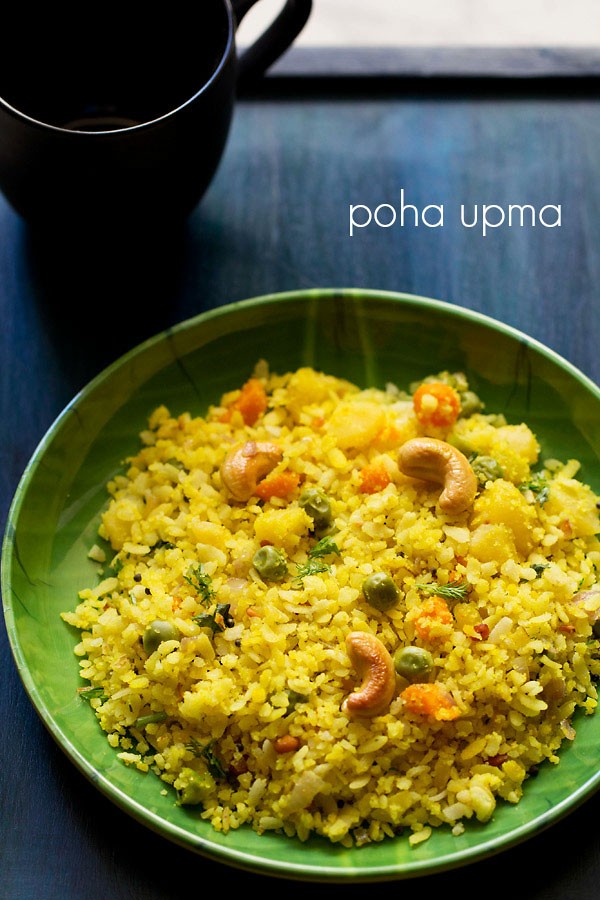
About Aval Upma
Both poha and Upma are quite a favorite choice for breakie, when it comes to me and my family. So, I regularly make both these dishes at home. What I love the most about these preparations is that they are quick to prepare and are quite nutritious too.
This recipe of Poha Upma is actually a South Indian version (Tamil, to be more precise). Hence, also referred to as Aval Upma as the Tamil word for ‘poha’ is ‘aval.’ At home, whenever I make the regular Maharashtrian Poha recipe, I usually have 2 variations for it – one with kanda (onion) and the other with kanda and batata (onion and potato).
Other than the flattened rice or poha, this Aval Upma has more or less those ingredients which are traditionally used in a rava upma. Like mustard seeds, chana dal, urad dal, ginger, green chilies, curry leaves, onion, cashews, etc.
Some added ingredients in this specific Tamil style Poha Upma are asafoetida, coconut and turmeric powder due to which it is also yellow in color, and not white. In case you want to make a vegan-friendly version of this upma, skip the asafoetida.
More on Aval Upma
I also add some vegetables like potato, carrot and green peas in this Aval Upma. But this is not mandatory, as I may skip adding these sometimes. You can steam the veggies first and then add or cook the veggies along with the tempering and then add the poha. Choose whatever is easy for you.
However, if you are cooking the vegetables with the tempering for this Poha Upma, then you will have to add some water. Cover the pan and cook the veggies. Once the vegetables soften, simmer till the moisture dries up before adding the flattened rice.
Poha or flattened rice/beaten rice/parched rice is used extensively in Indian cuisine. Just like this Aval Upma, there are a variety of other dishes that you can make with this wonder ingredient, which is basically a form of rice. Some more well-known Indian preparations with flattened rice include:
You can serve this wholesome vegetable Poha Upma with your morning cup of tea or coffee or also as a hearty evening snack.
How to make Aval Upma
Preparation
1. You will need to steam vegetables, if you plan to add them. I used 1 potato, 1 carrot and ⅓ cup green peas. Once steamed, peel and chop the potato and carrot and keep aside. You can also cook the vegetables directly with the tempering in the pan or skip the vegetables.
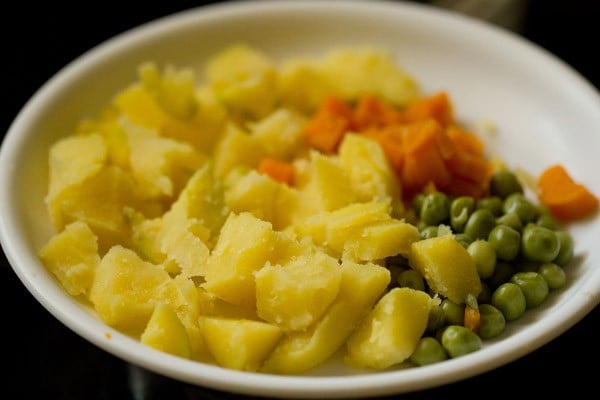
2. Rinse 2 cups thick poha with water in a colander or strainer for a couple of times. Move the poha with your hands while rinsing. The poha just needs to get softened. So, rinse gently.
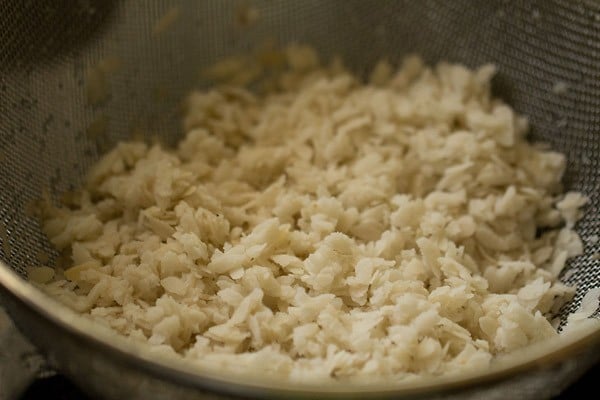
3. Add ½ teaspoon turmeric powder, ½ teaspoon sugar and salt as required to the poha.
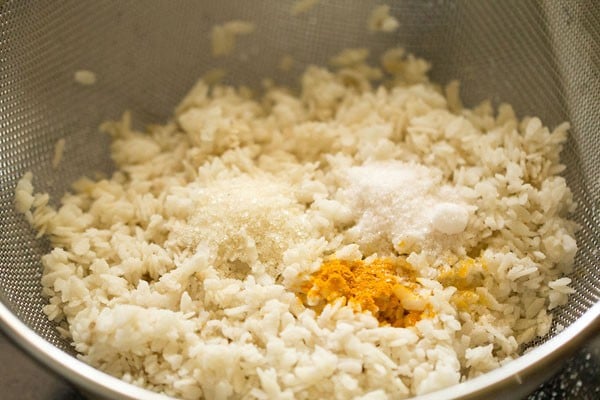
4. Mix gently. Keep aside.
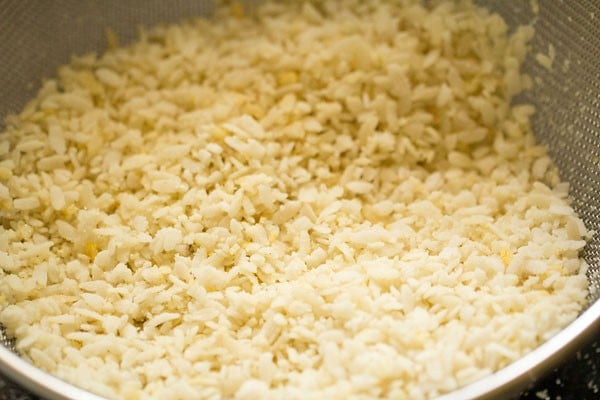
Making tempering
5. In a pan, heat 2 tablespoons oil and add 1 teaspoon mustard seeds.
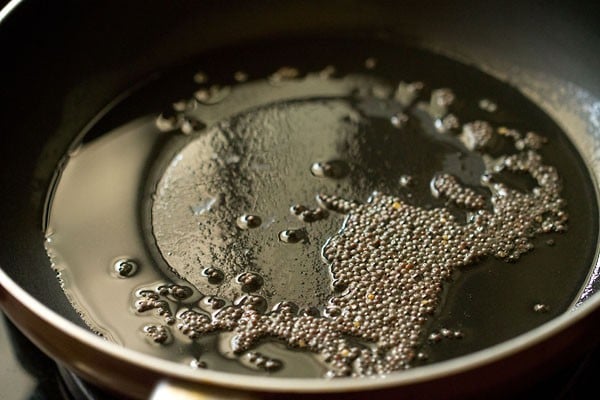
6. When the mustard seeds crackle, add 1 teaspoon chana dal (optional), 1 teaspoon urad dal (optional) and 10 to 12 cashews. You can also add 1 tablespoons peanuts, instead of cashews.
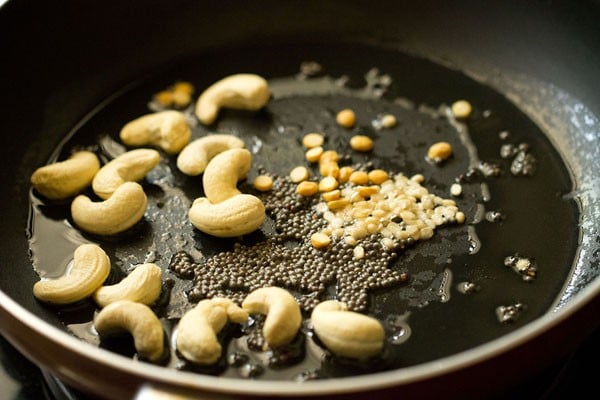
7. Stir and sauté till both the dals and cashews turn golden.
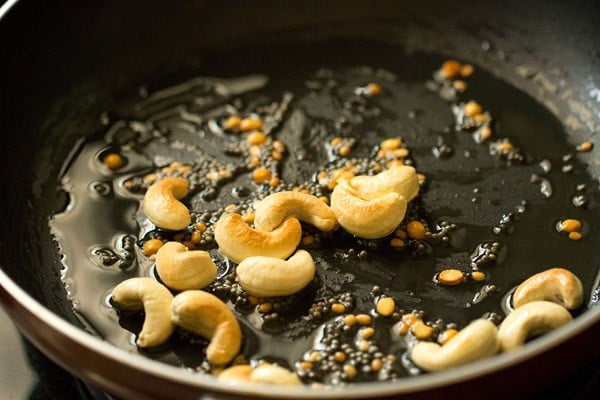
8. Now, add ⅓ cup finely chopped onion, 1 teaspoon finely chopped ginger, 1 teaspoon chopped green chilies, 1 dried red chili, 8 to 10 curry leaves and a pinch of asafoetida (optional).
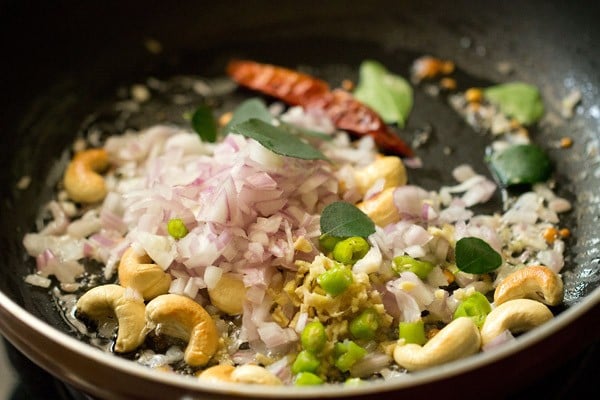
10. Stir and sauté till the onions turn translucent.
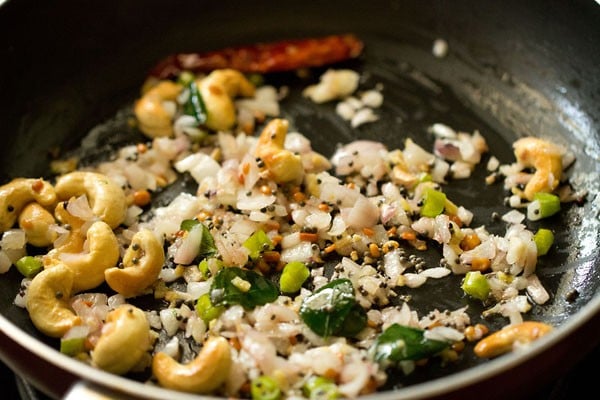
Making Aval Upma
11. Add the vegetables
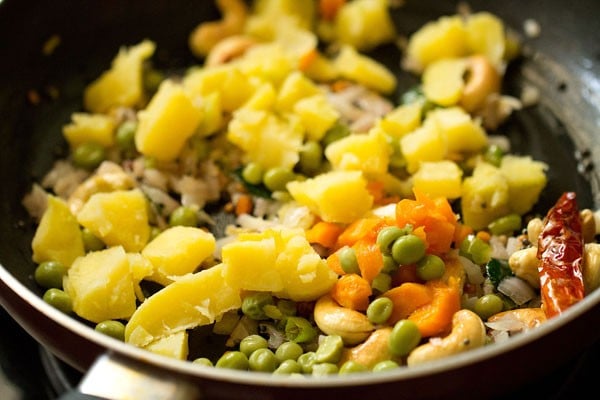
12. Stir very well.
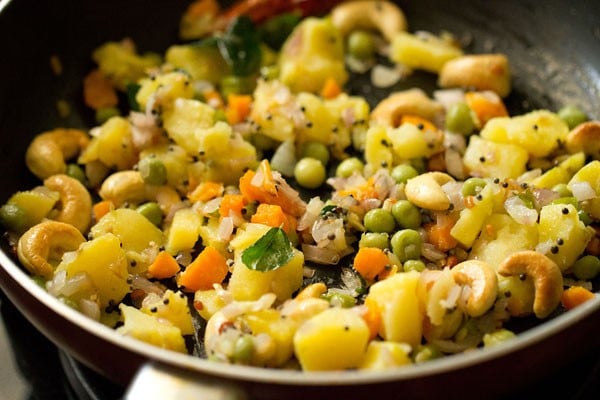
13. Then, add the poha.
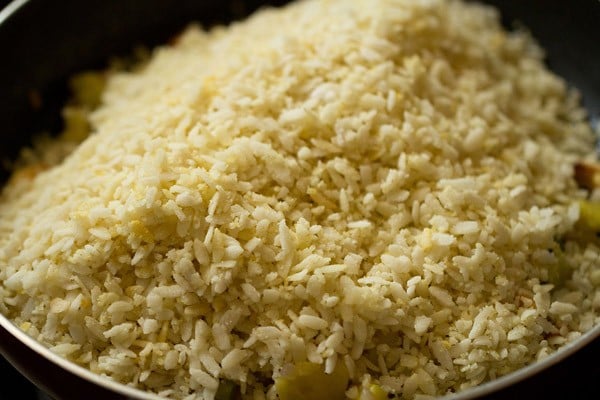
14. Stir and mix gently. Check the taste and add more salt or sugar, if required.
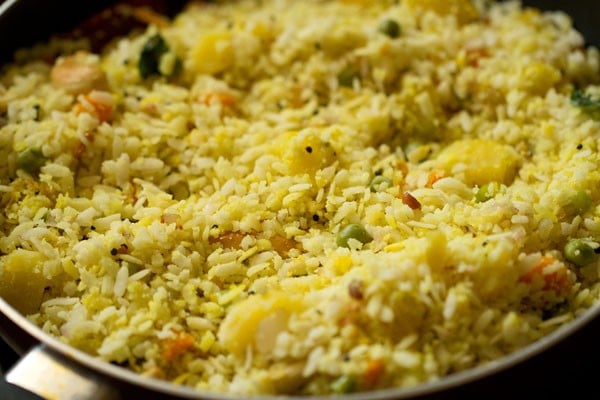
15. Ensure that everything gets mixed evenly and cook on low heat for 3 to 4 minutes. After mixing, you can also cover the pan and allow the Poha Upma to steam for 3 to 4 minutes on low heat.
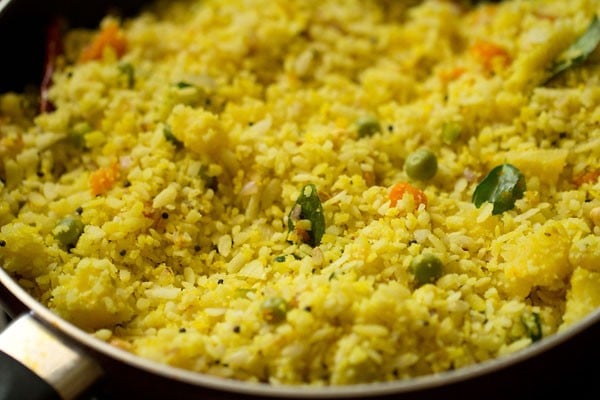
16. Lastly, add 2 to 3 tablespoons chopped coriander leaves and mix gently. You can also add 2 to 3 tablespoons grated fresh coconut, drizzle some lime or lemon juice and mix.
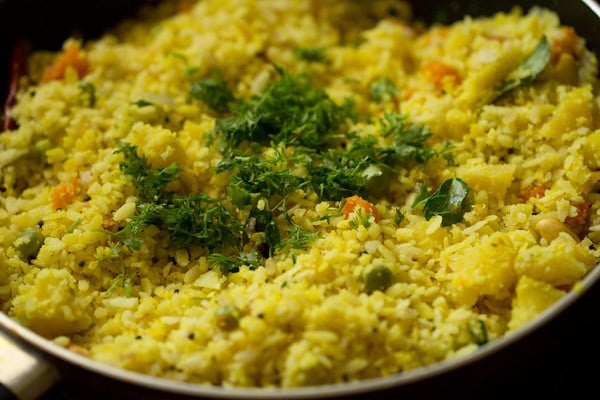
17. Serve Aval Upma hot or warm with lemon or lime slices or Lemon Pickle.
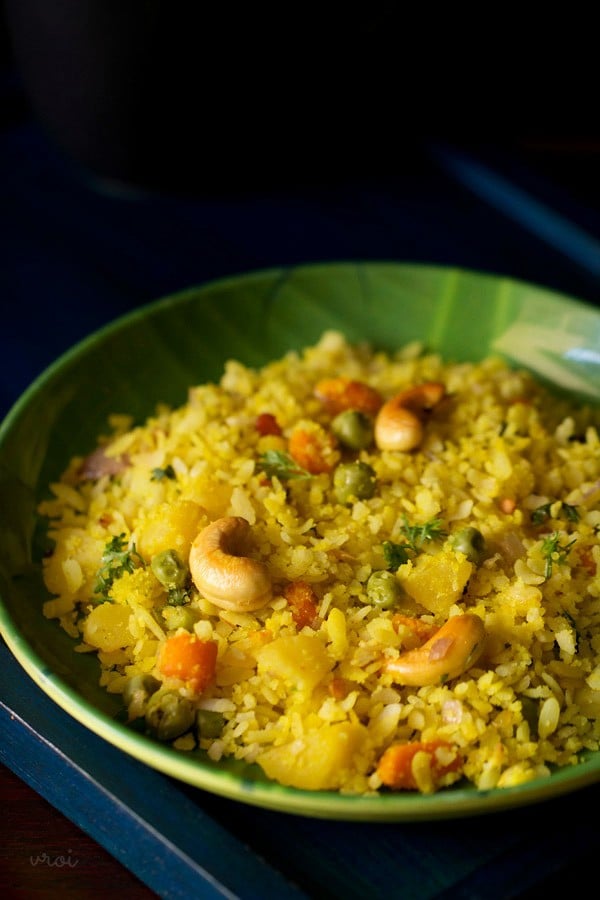
Expert Tips
- While rinsing the flattened rice or poha, make sure to move it with your hands. It just needs to get softened. So, make sure to rinse gently.
- You can make this upma with or without veggies. If adding veggies, you can steam and add them. Or cook them directly with the tempering in the pan.
- If adding green peas, choose either fresh or frozen. Add whatever is available in your home kitchen.
- Chana dal (split husked Bengal gram), urad dal (split husked black gram) and asafoetida (hing) are optional in this recipe. You can make this upma without these as well.
- Instead of cashews, you can also add 1 tablespoon peanuts in this recipe.
- You can increase the quantity of green chilies if you want to have a spicier upma.
- Before serving, you can garnish the upma with grated fresh coconut and drizzle some lemon juice on top and mix. Or else you can also serve the upma with lemon slices on the side.
More Aval Recipes To Try!
Sweets Recipes
Gluten Free Recipes
Breakfast Recipes
Breakfast Recipes
Please be sure to rate the recipe in the recipe card or leave a comment below if you have made it. For more vegetarian inspirations, Sign Up for my emails or follow me on Instagram, Youtube, Facebook, Pinterest or Twitter.
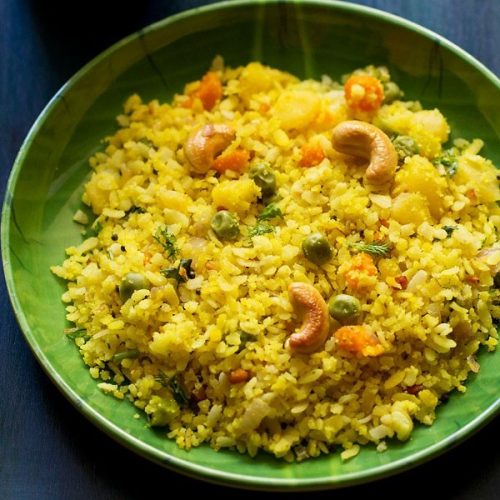
Aval Upma | Poha Upma
Ingredients
prep ingredients for aval upma
- 2 cups thick poha (parched rice or flattened rice)
- ½ teaspoon turmeric powder
- ½ teaspoon sugar or add as per taste
- salt as required
veggies
- 1 medium potato
- 1 small to medium carrot
- 1/3 cup green peas – fresh or frozen
tempering and other ingredients
- 2 tablespoon oil
- 1 teaspoon mustard seeds
- 1 teaspoon chana dal (split husked bengal gram)
- 1 teaspoon urad dal (split husked black gram)
- 10 to 12 cashews or 1 tablespoon peanuts
- 1 dried red chili
- 1 or 2 green chilies – chopped
- ½ inch ginger – finely chopped
- 8 to 10 curry leaves
- 1 pinch asafoetida (hing)
- 1 medium onion, finely chopped or 1/3 cup finely chopped onion
- 2 tablespoon grated coconut (optional)
- 2 to 3 tablespoon chopped coriander leaves
- 1 small lime or lemon for serving
Instructions
prepping veggies
- You will need to steam veggies if you plan to add them. I used 1 potato, 1 carrot and some peas.
- Once steamed, peel and chop the potato and carrot and keep aside. You can also cook the veggies directly with the tempering in the pan. You can even skip the veggies.
prepping poha
- Rinse 1 cup thick poha in water in a colander or strainer for a couple of times. The poha just need to get softened. So rinse gently.
- Add 1/2 tsp turmeric powder, sugar and salt to the poha.
- Mix gently. Keep aside.
tempering and making poha upma
- In a pan, heat 2 tbsp oil and add 1 tsp mustard seeds.
- When the mustard seeds crackle, add 1 tsp chana dal (optional), 1 tsp urad dal (optional) and 10 to 12 cashews. You can also add peanuts instead of cashews.
- Stir and saute till both the dals and cashews turn golden.
- Now add 1/3 cup finely chopped onion, 1 tsp finely chopped ginger, 1 tsp chopped green chilies, 1 dry red chili, 8 to 10 curry leaves and a pinch of asafoetida (optional).
- Stir and saute till the onions turn translucent.
- Add the veggies and stir very well.
- Then add the poha. Stir and mix gently. Check the taste and add more salt or sugar if required.
- Ensure that everything gets mixed evenly and cook on a low flame for 3 to 4 minutes. After mixing you can also cover the pan and allow the upma to steam for 3 to 4 minutes on a low flame.
- Lastly add 2 to 3 tbsp chopped coriander leaves and mix gently.
- You can also add 2 to 3 tbsp grated coconut at this step. You can also drizzle some lime or lemon juice and mix. Or serve the poha upma with lime slices.
- Serve poha upma hot or warm with lemon or lime slices or a lemon pickle.
Notes
- The addition of vegetables is optional.
This Aval Upma Recipe from the archives was first published in June 2015. It has been updated and republished in April 2024.
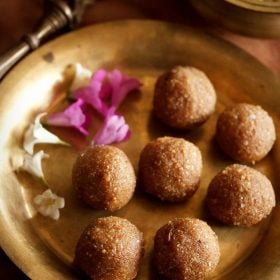
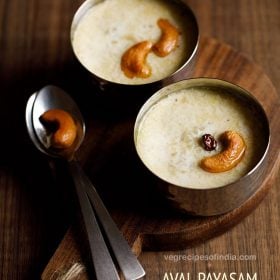
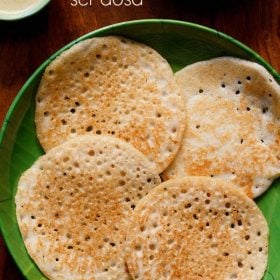



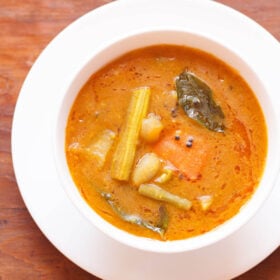








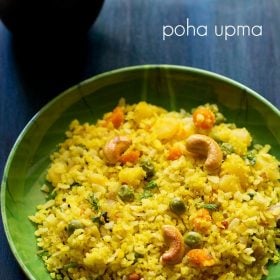
I am an American who loves cooking authentic Indian food. Your recipes are instructive and easy to follow. Thank you!
Thanks a lot Jennifer and glad to read your feedback. Most welcome and happy cooking.
Tried this version today.it was simply awesome.loved the variation of adding veggies to the poha.i usually add corn or moong sprouts.but this mix also works well.
thanks winnie. glad you liked the poha upma recipe. the vegetables add a nice soft texture and taste good. in fact, you can add a complete mix of veggies, corn and moong sprouts. thanks again.
Please do mention some dishes exclusively made from thin poha for breakfast. Thanks in advance.
will try to add.
can we add any kind of dry masala powders in this recipe?
usually no masala is added, but any recipe can be improvised. you can add dry masalas, but the taste will change.
Its really very useful for single living alone,,Thank you very much !!
welcome and thankyou chander 🙂
Thanks for the way u explain…it is so easy and really helpfull..now i enjoy cooking.
glad to know this abhishek for your kind words and you are welcome.
Could I have a calorific value to the poha dish that was made and is on this web site.
thanks
welcome kishore. I dont know the calorific value.
Hi…..you have written 2 cups of flattened rice in the ingredients but wrote 1 cup in the method..which one measure should I follow?
its 2 cups. thanks for pointing out the error. i have corrected it.
Hi, ur receipes are just superb
I have tried a few of them and they were loved by my family. Do keep adding more n more receipes especially for kids. Thanq
welcome pooja. glad to know this. thanks for sharing positive feedback.
Hi,
Whenever I try to add chana dal or urad dal to any tempering it doesn’t get soft while cooking, so it feels little hard while eating.
Thanks,
Vandana
Both the dals have to be sauteed till golden. urad dal is fine but chana dal does taste hard at times. So try soaking both the dals in hot water for 30 to 40 minutes. Drain them and add to the tempering.
I tried this recipe..its really awesome.
thanks pavani for the positive review.
thanks
Hi Dassana,
The recipes I have tried have been so wonderful. My question is, what does adding the chana dal do for this recipe?
Next I will be trying the vegan lemon muffins!
thanks a lot,
Alex
thanks alex. chana dal adds some flavor and taste. but you can skip adding them.
If I want to use ram instant of sugar than what measurement I used
could not understand your comment.
Hello Mam,
I have one question not for this recipe while for cakes(unable to post this question in eggless banana cake recipe boz there is no any ”leave a reply”section) that which type of cake pan should i purchased? There are variety of product available in the mkt. plzz mam suggest i want to make a cake.
better to use an aluminium pan as they conduct heat very well. even cast iron pans are good, but they are too expensive. avoid the silicon moulds and pans as the baked goodies do not brown well.
I will try this recipe.
i love ur recipes yaar.d
this is such a wonderful site.and the way u r explaining recipes its awesome.
after finding dis dis site i forgot every cooking site.u r doing a great job.a
n i can say u r a very nice person too……………..
u r heling many people.
u have developed a confidence in me for cooking anything.
thanku so much Daasna.
god bless u n ur family
welcome shikha. thanks a lot for writing this sweet and encouraging feedback. glad to read your words. thanks for your prayers. you have motivated me to keep on blogging.
A wonderful site for vegetarians…..every time I think of writing back, but once the recipe is ready, the tasting starts off…writing while making the recipe….thanks for the good writeup and step by step instructions…. The first site I check for any recipe since I am sure its going to come out good…..just awesome !!
welcome vidhya. glad to know this. thanks for trying the recipes and sharing your positive review.
Ymmmi nd great learning by this way best of luck
I love all of your recepies…tthnks for posting such lovely recepies. Im kind of addicted of cooking can’t resist the urge to try different cuisines specially gujrati cusine is my favorite
U r the best guide for my passion thank u sooo much.
welcome dimple. thanks for sharing positive feedback and for your kind words.
Hi Dasana,
It looks delicious and easy to make on a busy morning. A request for Andhra Masala Vada recipe please.
thanks swetha. i have noted down your request.